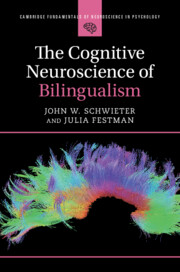Book contents
- The Cognitive Neuroscience of Bilingualism
- Cambridge Fundamentals of Neuroscience in Psychology
- The Cognitive Neuroscience of Bilingualism
- Copyright page
- Contents
- Figures
- Tables
- Acknowledgments
- Chapter One Theories and Methods in the Cognitive Neuroscience of Bilingualism
- Chapter Two Neural Representations and Language Processing in the Bilingual Brain
- Chapter Three Bilingualism, Language Development, and Brain Plasticity
- Chapter Four Aphasia and the Bilingual Brain
- Chapter Five Cross-Linguistic Effects of Bilingualism
- Chapter Six Bilingual Lexical and Conceptual Memory
- Chapter Seven Cognitive and Neurocognitive Effects of Bilingualism
- Chapter Eight Conclusion
- References
- Index
- References
Chapter Five - Cross-Linguistic Effects of Bilingualism
Published online by Cambridge University Press: 01 October 2023
- The Cognitive Neuroscience of Bilingualism
- Cambridge Fundamentals of Neuroscience in Psychology
- The Cognitive Neuroscience of Bilingualism
- Copyright page
- Contents
- Figures
- Tables
- Acknowledgments
- Chapter One Theories and Methods in the Cognitive Neuroscience of Bilingualism
- Chapter Two Neural Representations and Language Processing in the Bilingual Brain
- Chapter Three Bilingualism, Language Development, and Brain Plasticity
- Chapter Four Aphasia and the Bilingual Brain
- Chapter Five Cross-Linguistic Effects of Bilingualism
- Chapter Six Bilingual Lexical and Conceptual Memory
- Chapter Seven Cognitive and Neurocognitive Effects of Bilingualism
- Chapter Eight Conclusion
- References
- Index
- References
Summary
For bilinguals, the use and knowledge of one language affects how they process the other. Various cross-linguistic influences (CLI) can be observed in both language production and comprehension across all domains of linguistics. We start by broadly exploring the concept of transfer, both negative and positive, and forward and reverse. In doing so, we identify various classifications of CLI. Following this, we review key studies on phonological, lexical, morphological, and syntactic transfer along with other types such as discursive, pragmatic, and sociolinguistic. We find that there are a number of factors that can determine the degree to which transfer emerges or whether it happens at all. We then review studies investigating the ability to switch between the two language systems. In doing so, we look at theoretical models that explain what facilitates language switching and what empirical studies tell us about the neural and electrophysiological activity that arises in language switching. Finally, we discuss dreaming and bilingualism and argue that dreaming in an L2, contrary to popular belief, does not necessarily imply fluency in that language.
Keywords
- Type
- Chapter
- Information
- The Cognitive Neuroscience of Bilingualism , pp. 99 - 125Publisher: Cambridge University PressPrint publication year: 2023

